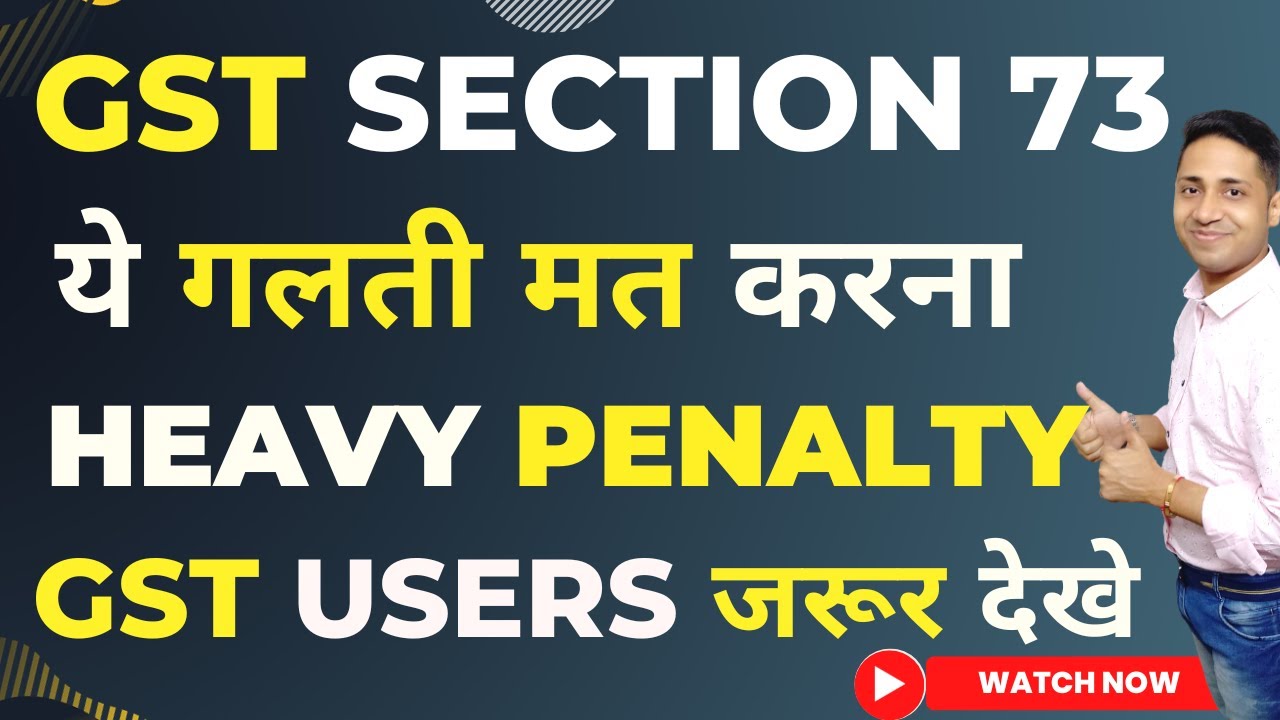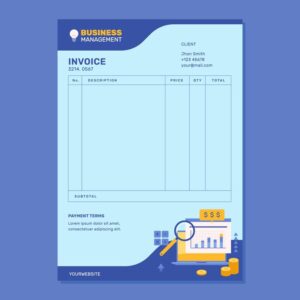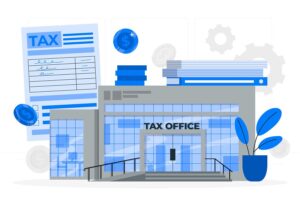Penalty Under Section 73 of GST
- 29 Jan 25
- 9 mins

Penalty Under Section 73 of GST
- What Is Section 73 of the CGST Act?
- Purpose and Applicability of Section 73
- Time Limits for Issuance of Notice
- Steps for Demand and Recovery Under Section 73
- Penalties and Interest Under Section 73
- How Is this Different from Section 74?
- Practical Example of Section 73 Application
- How to Respond to a Notice Issued Under Section 73?
- Rights of the Taxpayer Under Section 73
- Common Mistakes That Lead to Section 73 Notices
- Conclusion
Key Takeaways
- Section 73 allows taxpayers to correct GST errors before penalties are applied.
- It addresses underpayment and incorrect claims, excluding fraud or evasion.
- Penalties are 10% of the tax or ₹10,000, plus 18% interest on overdue payments.
- Paying taxes and interest before the order avoids penalties under Section 73.
- Mistakes like wrong HSN codes or incorrect ITC claims trigger Section 73 notices.
Section 73 of the CGST Act ensures fairness in the tax system. However, taxpayers can get a penalty under Section 73 of GST if they make certain mistakes. This blog will go into some of these mistakes, what Section 73 entails, its purpose and applicability, time limits before a legal notice is issued, etc. It will also discuss the steps of demand and recovery, penalties and interests under the section, and other details.
What Is Section 73 of the CGST Act?
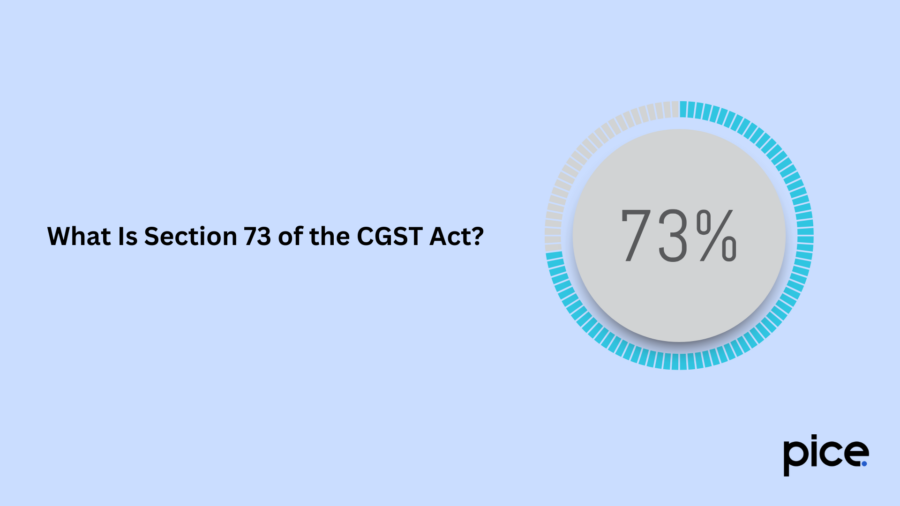
Section 73 of the CGST Act goes over determining the GST demand in common cases where there is no ambiguous motive, such as fraud, suppressing facts, or providing wilful misstatement. These scenarios include whether the tax is not paid correctly, erroneous refunds of taxes, or the tax paid is less than the actual liability. Also, the input tax credit (ITC) under Section 73 of the CGST Act 2017 may have been wrongly availed or utilised.
Purpose and Applicability of Section 73
Section 73 of the Central Goods and Services Tax (CGST) Act deals with the process of recovering taxes when a person has either not paid or has incorrectly paid GST. The primary purpose of this section is to ensure that any shortfall or error in the payment of tax is corrected by the taxpayer and to avoid severe penalties.
It allows tax authorities to initiate recovery actions if they find that the tax liability has been understated or if there has been an incorrect classification of goods or services.
This section applies to situations where there is a mistake in paying taxes, such as underreporting of sales or not applying the right tax rate. However, it does not cover cases of fraud or willful evasion of taxes, which are dealt with separately under Section 74.
Time Limits for Issuance of Notice
Section 73 of the CGST Act 2017 states that the demand notice should be served a minimum of 3 months before the final order is issued. Here, the Demand and Recovery Certificate (DRC) series of forms are used for the GST demand procedure under section 73 of the CGST Act.
Earlier, Section 73 of the CGST Act had no clear time limits, leading to confusion between the taxpayers. Also, there was no defined time limit on the completion period for the demand procedure.
The newly included section 74A has clearly stated the time limits of the service of notice. These time limits are given below:
- The Demand notice should be issued within 42 days of the final date of filing the annual return or receiving the incorrect refund.
- The final order should be given within 12 months after the issuance of notice.
- A joint commissioner or other higher-ranked officer can extend this period for a maximum of six months.
Steps for Demand and Recovery Under Section 73
These are the steps for demand and recovery under Section 73:
- Initiation of Proceedings
At first, the tax authorities will initiate proceedings if there is a suspicion that a taxpayer has either underpaid the tax or has evaded paying it. There might be different reasons for it, such as discrepancies in the returns filed, reports from audits, etc.
- Issue of Show Cause Notice (SCN)
Once the authorities suspect tax evasion or underpayment, they issue a Show Cause Notice (SCN) to the taxpayer. This issue of notice is a formal communication from the tax department, which explains the reasons for their suspicion and asks the taxpayer to explain why the tax should not be demanded from them.
- Reply to Show Cause Notice
The taxpayer must reply to the SCN within the prescribed time limit. This time limit is usually 30 days from the date of receipt of the notice.
- Issuance of Demand Notice
The tax officer, after considering the taxpayer's reply, will decide whether the demand for taxes is valid. If they find that the tax was underpaid, they will issue a demand notice.
- Payment of Tax
Once the demand notice is issued, the taxpayer must pay the amount specified in the notice. This includes the outstanding tax and the interest for delayed payment (it is calculated from the date the tax was due). It will also include the penalty amount, if applicable.
- Recovery of Tax
The tax authorities can initiate recovery proceedings if the taxpayer does not pay the amount specified in the notice within the stipulated time.
- Appeal Against Demand
If the taxpayer disagrees with the demand notice, they have the option to file an appeal before the appropriate authority.
Penalties and Interest Under Section 73
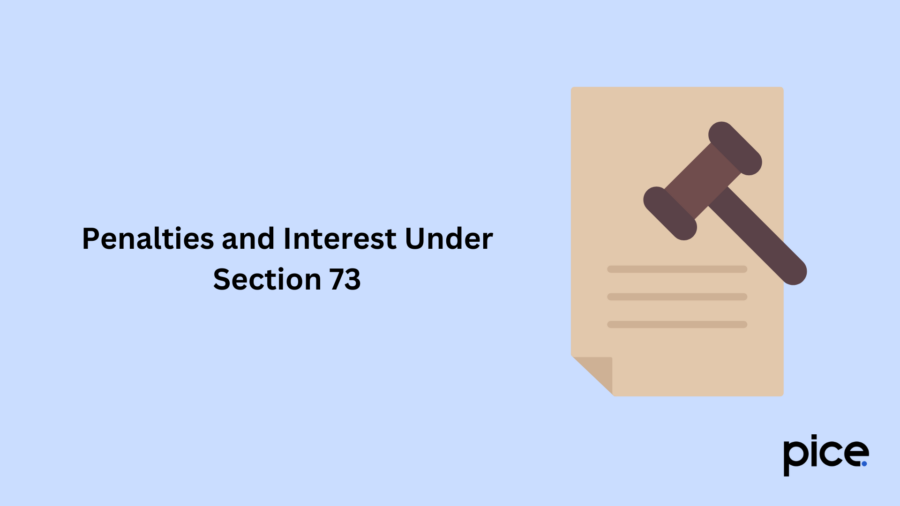
The tax officer might impose hefty penalties or charge interests to businesses if they make an error. The taxpayer must pay the amount of tax, interest, and a penalty equivalent to 10% of tax or ₹10,000, whichever is higher. As for interest, an 18% interest per annum on the tax amount is charged from the due date to the payment date.
How Is this Different from Section 74?
There are some differences between Section 73 and Section 74 of the CGST Act, such as:
| Section 73 | Section 74 | |
| Time Periods for Issuing an Order | 3 years | 5 years |
| Penalty Amount | 10% of the tax payable or ₹10,000, whichever is higher. | Equivalent to tax dues when there is an occurrence of fraud, suppression of facts, or deliberate misstatement. |
| Penalty Relief- Voluntary Payment Before Issuance Of Show-Cause Notice. | Zero penalty if a full payment of tax + interest is paid | Penalty at 15% of tax |
| Penalty Relief: Voluntary Payment Following Show-Cause Notice. | Zero penalty if it is paid within 30 days from the date of issuance of the SCN | Penalty @ 25% of tax (time limit 30 days) or,Penalty @ 50% of tax (time limit 30 days) depending on the conditions |
| Basis Of Tax Notice | This can be determined by the assumptions of the proper officer of the tax department. | Can be determined by the suspicion of the proper officer of the tax department. |
Practical Example of Section 73 Application
Suppose a company named XYZ Manufacturer has wrongly claimed input tax credit for a transaction, and the tax department has issued a notice under Section 73 to recover a sum of ₹5,00,000. Now, XYZ Manufacturer has acknowledged the error, agreeing to pay off this due amount within the prescribed time frame. After which, the penalty was waived as the company made the payment before the order was issued.
How to Respond to a Notice Issued Under Section 73?
Taxpayers should do this if they receive a notice under Section 73:
- Taxpayers should understand the particular allegations and the amounts involved.
- Then, they should collect all important records, including returns, invoices, and ledgers.
- Next, the taxpayers must analyse if the tax department has made a valid claim or if the taxpayer can justify their position.
- After which, they should come up with detailed responses to notices alongside supporting evidence.
- Taxpayers can also talk with a tax professional for complex matters.
- The taxpayers must provide a prompt reply to the tax department within the time limit mentioned.
Rights of the Taxpayer Under Section 73
Taxpayers have some rights under Section 73 of the CGST Act to ensure a fair process. These are:
- Taxpayers may present their case before any adverse order is issued.
- If they are dissatisfied with the order, they can file an appeal with higher authorities.
- Taxpayers can pay the fee before the order gets issued to avoid fines.
- They can get representation from a chartered accountant or legal consultant.
- Taxpayers can request information about the basis of the demand that was calculated.
Common Mistakes That Lead to Section 73 Notices
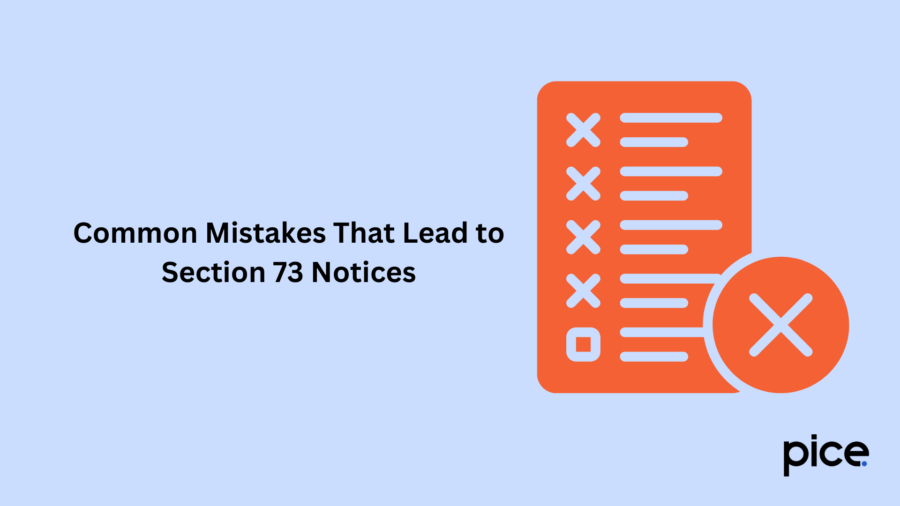
Here are the common mistakes that may lead to Section 73 notices:
- The taxpayers may incorrectly classify their goods or services and use the wrong HSN code, which can result in underpaying the tax.
- They might claim incorrect input tax credits on items that are not eligible for claims.
- If someone mistakenly considers certain supplies to be exempt from taxes.
- There might be some calculation errors while calculating tax liability and some errors in filing returns.
- Businesses might forget to include some sales or purchases in returns while filing returns.
Conclusion
Section 73 of the CGST Act ensures tax compliance by allowing taxpayers to correct their mistakes, like underpayment or incorrect GST claims, before tax authorities impose a penalty under Section 73 of GST. It provides a fair process for taxpayers to take care of issues such as wrong Input Tax Credit (ITC) claims or errors in tax payment to reduce their burden of penalty.
This blog has discussed some important details of this section, such as purpose and applicability, time limits for issuance of a notice, the demand and recovery process, etc., in brief.
💡If you want to streamline your payment and make GST payments, consider using the PICE App. Explore the PICE App today and take your business to new heights.







